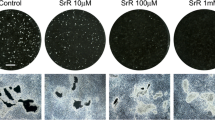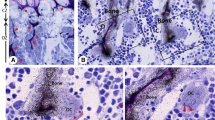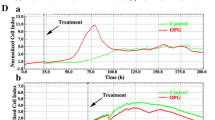Abstract
An experiment was designed to investigate whether systemic administration of tetracyclines (TCs) as bone fluorochrome labels could interfere with bone modeling in vivo and inhibit osteoclast formation and activity in vitro. Cell cultures of rat bone marrow macrophages revealed that TC and oxytetracycline inhibited osteoclastogenesis and bone resorption and stimulated apoptosis. Forty rats in five groups were treated with saline, calcein green, alizarin red S, TC, or oxytetracycline. Their tibias were used for histomorphometric analysis, including bone static, dynamic, and resorption parameters in the tibial proximal metaphysis. No significant differences in bone volume per tissue volume, trabecular number, trabecular thickness, trabecular separation, bone formation rate per bone surface, mineralizing surface, or mineral apposition rate were observed. TC or oxytetracycline decreased eroded surface, number of osteoclasts per bone perimeter, and osteoclast surface per bone surface by about 50%. The results demonstrated that TC and oxytetracycline inhibit rat osteoclast formation and activity in vitro, and histomorphometric parameters involved in bone turnover may be affected by the use of oxytetracycline and TC as fluorescent bone labels in vivo.


Similar content being viewed by others
References
Golub LM, Soummalainen K, Sorsa T (1992) Host modulation with tetracyclines and their chemically modified analogues. Curr Opin Dent 2:80–90
Shapira L, Soskolne WA, Houri Y, Barak V, Halabi A, Stabholz A (1996) Protection against endotoxic shock and lipopolysaccharide induced local inflammation by tetracycline: correlation with inhibition of cytokine secretion. Infect Immun 64(3):5–8
Golub LM, Lee HM, Ryan ME, Giannobile WV, Payne J, Sorsa T (1998) Tetracyclines inhibit connective tissue breakdown by multiple non-antimicrobial mechanisms. Adv Dent Res 12:12–26
Rifkin BR, Vernillo AT, Golub LM, Ramamurthy NS (1994) Modulation of bone resorption by tetracyclines. Ann NY Acad Sci 732:165–180
Golub LM, Evans RT, McNamara TF, Lee HM, Ramamurthy NS (1994) A non-antimicrobial tetracycline inhibits gingival matrix metalloproteinases and bone loss in Porphyromonas gingivalis-induced periodontitis in rats. Ann NY Acad Sci 732:96–111
Lambs L, Venturini M, Decock-Le Révérend B, Kozlowski H, Berthon G (1988) Metal ion-tetracycline interactions in biological fluids. Part 8. Potentiometric and spectroscopic studies on the formation of Ca(II) and Mg(II) complexes with 4-dedimethylamino-tetracycline and 6-desoxy-6-demethyl-tetracycline. J Inorg Biochem 33:193–210
Chopra I, Roberts M (2001) Tetracycline antibiotics: mode of action, applications, molecular biology, and epidemiology of bacterial resistance. Microbiol Mol Biol Rev 65:232–260
Lokeshwar BL, Selzer MG, Zhu BQ, Block NL, Golub LM (2002) Inhibition of cell proliferation, invasion, tumor growth and metastasis by an oral non-antimicrobial tetracycline analog (COL-3) in a metastatic prostate cancer model. Int J Cancer 98:297–309
Amin AR, Attur MG, Thakker GD, Patel PD, Vyas PR, Patel RN, Patel IR, Abramson SB (1996) A novel mechanism of action of tetracyclines: effects on nitric oxide synthases. Proc Natl Acad Sci USA 93:14,014–14,019
Bettany JT, Peet NM, Wolowacz RG, Skerry TM, Grabowski PS (2000) Tetracyclines induce apoptosis in osteoclasts. Bone 27:75–80
Zhang C, Tang TT, Ren WP, Zhang XL, Dai KR (2007) Inhibiting wear particles-induced osteolysis with doxycycline. Acta Pharmacol Sin 28(10):1603–1610
Sun TC, Mori S, Roper J, Brown C, Hooser T, Burr DB (1992) Do different fluorochrome labels give equivalent histomorphometric information? Bone 13:443–446
Lin BY, Jee WS, Ma YF, Ke HZ, Kimmel DB, Li XJ (1994) Effects of prostaglandin E2 and risedronate administration on cancellous bone in older female rats. Bone 15:489–496
Takahashi N, Akatsu T, Sasaki T, Nicholson GC, Moseley JM, Martin TJ, Suda T (1988) Induction of calcitonin receptors by 1, 25-dihydroxyvitamin D in osteoclast-like multinucleated cells formed from mouse bone marrow cells. Endocrinology 123:1504–1510
Takeshita S, Kaji K, Kudo A (2000) Identification and characterization of the new osteoclast progenitor with macrophage phenotypes being able to differentiate into mature osteoclasts. J Bone Miner Res 15:1477–1488
Ren WP, Yang SY, Wooley PH (2004) A novel murine model of orthopaedic wear debris-associated osteolysis. Scand J Immunol 33:1–10
el-Hakim IE (1999) The effect of fibrin stabilizing factor (F.XIII) on healing of bone defects in normal and uncontrolled diabetic rats. Int J Oral Maxillofac Surg 28:304–308
Parfitt AM, Drezner MK, Glorieux FH, Kanis JA, Malluche H, Meunier PJ, Ott SM, Recker RR (1987) Bone histomorphometry: standardization of nomenclature, symbols and units. Report of the ASMBR histomorphometry nomenclature committee. J Bone Miner Res 2:595–610
Golub LM, Ramamurthy NS, McNamara TF, Greenwald RA, Rifkin BR (1991) Tetracyclines inhibit connective tissue breakdown: new therapeutic implications for an old family of drugs. Crit Rev Oral Biol Med 2(3):297–321
Chang KM, Ramamurthy NS, McNamara TF, Evans RT, Klausen B, Murray PA, Golub LM (1994) Tetracyclines inhibit Porphyromonas gingivalis-induced alveolar bone loss in rats by a non-antimicrobial mechanism. J Periodont Res 29(4):242–249
Ryan ME, Usman A, Ramamurthy NS, Golub LM, Greenwald RA (2001) Excessive matrix metalloproteinase activity in diabetes: inhibition by tetracycline analogues with zinc reactivity. Curr Med Chem 8(3):305–316
Curci JA, Petrinec D, Liao S, Golub LM, Thompson RW (1998) Pharmacologic suppression of experimental abdominal aortic aneurysms: a comparison of doxycycline and four chemically modified tetracyclines. J Vasc Surg 28(6):1082–1093
Golub LM, McNamara TF, D’Angelo G, Greenwald RA, Ramamurthy NS (1987) A non-antibacterial chemically-modified tetracycline inhibits mammalian collagenase activity. J Dent Res 66(8):1310–1314
Greenwald RA, Golub LM, Ramamurthy NS, Chowdhury M, Moak SA, Sorsa T (1998) In vitro sensitivity of the three mammalian collagenases to tetracycline inhibition: relationship to bone and cartilage degradation. Bone 22(1):33–38
Trachtman H, Futterweit S, Greenwald R, Moak S, Singhal P, Franki N, Amin AR (1996) Chemically modified tetracyclines inhibit inducible nitric oxide synthase expression and nitric oxide production in cultured rat mesangial cells. Biochem Biophys Res Commun 229(1):243–248
Patel RN, Attur MG, Dave MN, Patel IV, Stuchin SA, Abramson SB, Amin AR (1999) A novel mechanism of action of chemically modified tetracyclines: inhibition of COX-2-mediated prostaglandin E2 production. J Immunol 163(6):3459–3467
D’Agostino P, Ferlazzo V, Milano S, La Rosa M, Di Bella G, Caruso R, Grimaudo S, Tolomeo M, Feo S, Cillari E (2001) Anti-inflammatory effects of chemically modified tetracyclines by the inhibition of nitric oxide and interleukin-12 synthesis in J774 cell line. Int Immunopharmacol 1(9–10):1765–1776
Kirkwood KL, Golub LM, Bradford PG (1999) Non-antimicrobial and antimicrobial tetracyclines inhibit IL-6 expression in murine osteoblasts. Ann NY Acad Sci 878:667–670
Vernillo AT, Ramamurthy NS, Golub LM, Rifkin BR (1994) The antimicrobial properties of tetracycline for the treatment of periodontal disease. Curr Opin Periodontol 2:111–118
Golub LM, Ciancio S, Ramamamurthy NS, Leung M, McNamara TF (1990) Low dose doxycycline therapy: effect on gingival and crevicular fluid collagenase in humans. J Periodont Res 25:321–330
Woodward JK, Holen I, Coleman RE, Buttle DJ (2007) The roles of proteolytic enzymes in the development of tumour-induced bone disease in breast and prostate cancer. Bone 41(6):912–917
Bettany JT, Wolowacz RG (1998) Tetracycline derivatives induce apoptosis selectively in cultured monocytes and macrophages but not in mesenchymal cells. Adv Dent Res 12:136–143
Baron R, Neff L, Tran Van P, Nefussi JR, Vignery A (1986) Kinetic and cytochemical identification of osteoclast precursors and their differentiation into multinucleated osteoclasts. Am J Pathol 122:363–378
Holmes SG, Still K, Buttle DJ, Bishop NJ, Grabowski PS (2004) Chemically modified tetracyclines act through multiple mechanisms directly on osteoclast precursors. Bone 35(2):471–478
Holmes S, Smith S, Borthwick L, Dunford J, Rogers M, Bishop N, Grabowski PS (2008) CMT3 alters mitochondrial function in murine osteoclast lineage cells. Biochem Biophys Res Commun 365(4):840–845
Vernillo AT, Rifkin BR (1998) Effects of tetracyclines on bone metabolism. Adv Dent Res 12:56–62
Lee TC, O’Brien FJ, Taylor D (2000) The nature of fatigue damage in bone. Int J Fatigue 22(10):847–853
Myers HM, Tochon-Danguy HJ, Baud CA (1983) IR absorption spectrophotometric analysis of the complex formed by tetracycline and synthetic hydroxyapatite. Calcif Tissue Int 35:745–749
Stepensky D, Kleinberg L, Hoffman A (2003) Bone as an effect compartment: models for uptake and release of drugs. Clin Pharmacokinet 42:863–881
White JR, Pearce FL (1982) Characterization of chlortetracycline (aureomycin) as a calcium ionophore. Biochemistry 21:6309–6312
Nelson ML (1998) Chemical and biological dynamics of tetracyclines. Adv Dent Res 12:5–11
Williams S, Wakisaka A, Zeng QQ, Barnes J, Martin G, Wechter WJ, Liang CT (1996) Minocycline prevents the decrease in bone mineral density and trabecular bone in ovariectomized aged rats. Bone 19(6):637–644
Sasaki T, Ramamurthy NS, Golub LM (1998) Long-term therapy with a new chemically modified tetracycline (CMT-8) inhibits bone loss in femurs of ovariectomized rats. Adv Dent Res 12(2):76–81
Folwarczna J, Pytlik M, Janiec W (2003) Effects of doxycycline on development of changes in histomorphometric parameters of bones induced by bilateral ovariectomy in rats. Pol J Pharmacol 55(3):433–441
Garnero P, Ferreras M, Karsdal MA, Nicamhlaoibh R, Risteli J, Borel O (2003) The type I collagen fragments ICTP and CTX reveal distinct enzymatic pathways of bone collagen degradation. J Bone Miner Res 18(5):859–867
Chopin F, Garnero P, le Henanff A, Debiais F, Daragon A, Roux C (2008) Long term effects of Infliximab on bone and cartilage turnover markers in patients with rheumatoid arthritis. Ann Rheum Dis 67(3):353–357
Acknowledgment
The authors are grateful to Li Deqiang, Ph.D. (Shanghai Jiao Tong University School of Medicine, Shanghai, China), for providing the Annexin V-PI detection kit used in this study.
Author information
Authors and Affiliations
Corresponding author
Additional information
The authors have stated that they have no conflict of interest.
Rights and permissions
About this article
Cite this article
Zhou, X., Zhang, P., Zhang, C. et al. Tetracyclines Inhibit Rat Osteoclast Formation and Activity In Vitro and Affect Bone Turnover in Young Rats In Vivo. Calcif Tissue Int 86, 163–171 (2010). https://doi.org/10.1007/s00223-009-9328-5
Received:
Accepted:
Published:
Issue Date:
DOI: https://doi.org/10.1007/s00223-009-9328-5




